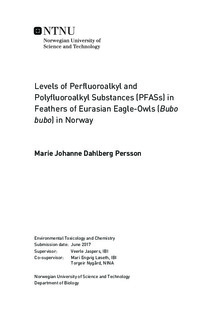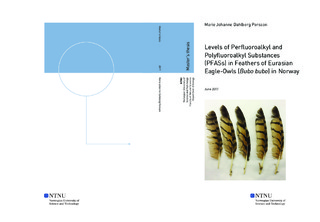| dc.description.abstract | In the current study per- and polyfluroalkyl substances (PFASs) were investigated in 72 feathers from Eurasian Eagle-Owls (Bubo bubo) collected in four geographically similar areas in Norway and in six different years. The objectives of the present study were to investigate accumulation of PFASs in feathers of Eagle-Owls, spatial and temporal trends of PFAS accumulation, and if PFAS exposure could be associated with the owls trophic position (15N) and feeding habits (13C).
No significant differences in PFAS levels were detected between sexes or sampling years. The highest concentration of sumPFASs was 98.6 ng/g dw from a feather from Frøya, coastal Central Norway (2013), while the lowest was 4.0 ng/g from Lurøy, Northern Norway (2015). The median level of sumPFAS detected in feathers from Southern Norway (41.59 ng/g dry weight (dw)), were more than twice as highs as in the feathers from the other areas (Coastal Central Norway: 21.37 ng/g dw; inland Central Norway: 10.77 ng/g dw; Northern Norway: 17.48 ng/g dw ). The most abundant PFASs at all locations were linear PFOS (Perfluorooctane sulfonic acid) - PFTriDA (Perfluorotridecanoic acid)-PFUnDA(Perfluoroundecanoic acid) - PFDoDA (Perfluorododecanoic acid). The PFAS profile was dominated by PFSAs (perfluoroalkyl sulfonic acids) in feathers from Northern Norway (54.07 %) and coastal Central Norway (51.76 %). While for Southern Norway and inland Central Norway sumPFCAs (perfluroalkyl carboxylic acids) was the main PFAS group (56.31 % and 59 % respectively). The pattern of median sumPFASs contamination was Southern Norway - Coastal Central Norway - Northern Norway - Inland Central Norway.
Stable isotopes (13C and 15N) were analyzed to elucidate dietary sources. A great variation in stable isotope data confirms the great diversity of the Eagle-Owls diet (d13C: -25.62 to-16.65 per mille; d15N 4.84 to 15.8 per mille), and reflecting possible dietary shifts of Eagle-Owls in some areas. The 15N data showed higher levels in feathers form Northern Norway (9.79 14.18 ) and coastal Central Norway (6.22 15.8 per mille), indicating that they feed on higher trophic levels. Accordingly, 13C data from these areas revealed that some of these owls have marine food sources in their diet (d13C > - 20 per mille ). The PFAS levels were only correlated with the stable isotope values in Northern Norway. The reason for this is unclear, but it may be explained by the lower sample sizes from the other areas which reduced the statistical power of the tests performed. Baseline values were unkown in the present study and more research is needed to investigate biomagnification of PFASs in Eagle-Owls. Further research of key prey species of Eagle-Owls are warranted to elucidate if the stable isotope values and PFAS levels represent spatial variation in PFAS exposure. Several factors can influence the contaminant accumulation, trophic behavior and feeding habits of the Eagle-Owls. Individuals differences in age and sex may be due to variation in physiology, diet, reproductive status or metabolic capacity. In conclusion, feathers seems to be useful as an alternative or complementary matrix to study PFAS exposure in Norwegian Eagle-Owls but more research is needed. | |

